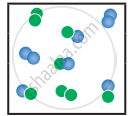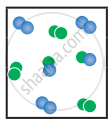Advertisements
Advertisements
प्रश्न
Which one of the following is incorrect statement ?
पर्याय
for a system at equilibrium, Q is always less than the equilibrium constant
equilibrium can be attained from either side of the reaction
presence of catalyst affects both the forward reaction and reverse reaction to the same extent
Equilibrium constant varied with temperature
उत्तर
for a system at equilibrium, Q is always less than the equilibrium constant
APPEARS IN
संबंधित प्रश्न
K1 and K2 are the equilibrium constants for the reactions respectively.
\[\ce{N2(g) + O2(g) <=>[K1] 2NO(g)}\]
\[\ce{NO(g) + O2(g) <=>[K2] 2NO2(g)}\]
What is the equilibrium constant for the reaction \[\ce{NO2(g) <=> 1/2 N2(g) + O2(g)}\]
\[\ce{[CO(H2O)6]^2+ (aq) (pink) + 4Cl- (aq) <=> [CoCl4]^2- (aq) (blue) + 6 H2O (l)}\]
In the above reaction at equilibrium, the reaction mixture is blue in colour at room temperature. On cooling this mixture, it becomes pink in color. On the basis of this information, which one of the following is true?
The equilibrium constants of the following reactions are:
\[\ce{N2 + 3H2 <=> 2NH3}\]; K1
\[\ce{N2 + O2 <=> 2NO}\]; K2
\[\ce{H2 + 1/2O2 <=> H2O}\]; K3
The equilibrium constant (K) for the reaction;
\[\ce{2NH3 + 5/2 O2 <=> 2NO + 3H2O}\], will be
For a given reaction at a particular temperature, the equilibrium constant has a constant value. Is the value of Q also constant? Explain.
When the numerical value of the reaction quotient (Q) is greater than the equilibrium constant, in which direction does the reaction proceed to reach equilibrium?
For the reaction, \[\ce{A2(g) + B2(g) <=> 2AB(g); \Delta H}\] is -ve.
the following molecular scenes represent differenr reaction mixture. (A-green, B-blue)
| Closed ← |
 |
 |
 |
| System | At equilibrium | (x) | (y) |
- Calculate the equilibrium constant Kp and (Kc).
- For the reaction mixture represented by scene (x), (y) the reaction proceed in which directions?
- What is the effect of an increase in pressure for the mixture at equilibrium?
Derive a general expression for the equilibrium constant Kp and Kc for the reaction, \[\ce{3H2(g) + N2(g) <=> 2NH3(g)}\].
Write the balanced chemical equation for an equilibrium reaction for which the equilibrium constant is given by expression.
`"K"_"C" = (["NH"_3]^4["O"_2]^5)/(["NO"]^4["H"_2"O"]^6)`
For the reaction
\[\ce{SrCO3(s) <=> SrO(s) + CO2(g)}\]
the value of equilibrium constant Kp = 2.2 × 10-4 at 1002 K. Calculate Kc for the reaction.
At particular temperature Kc = 4 × 10-2 for the reaction, \[\ce{H2S (g) <=> H2(g) +1/2 S2(g)}\]. Calculate the Kc for the following reaction.
\[\ce{2H2S (g) <=> 2H2 (g) + S2 (g)}\]
